 Huachuca
Illustrated, vol 1, 1993:
Huachuca
Illustrated, vol 1, 1993: Huachuca
Illustrated, vol 1, 1993:
Huachuca
Illustrated, vol 1, 1993:
chuca Illustrat
chuca Illustrat
Buffalo Soldiers at Huachuca:
The Battle of Carrizal
chuca Illus
uca Illustratrat
By the 19th of May, 1916, Huachuca's 10th Cavalry was in camp at Colonia Dublan alongside the 11th Cavalry. Here they would spend the remainder of their time in Mexico, with periodic scouting expeditions. The planes of the First Aerosquadron were out of commission, either wrecked or broken down, and could not be used for reconnaissance. So it was up to the cavalry to undertake the job of scouting.
 One such scouting expedition was sent out on 16 June to check on the
Mexican troop buildup around Ahumada. Captain Charles T. Boyd, in command
of C Troop, with Hank Adair as his lieutenant, was given orders to recon
in the vicinity of the Santa Domingo Ranch and to avoid any clash with Mexican
forces. Similar orders were issued to Captain Lewis S. Morey, Troop K. Captain
George B. Rodney watched as Boyd's troop left camp and he counted the men
as they rode past. "...Sixty-four men in column, joking and laughing
as they filed out of camp; then his 'point' of four men shot to the front
and he and Adair waved their hands to me in laughing adieu."(69)
One such scouting expedition was sent out on 16 June to check on the
Mexican troop buildup around Ahumada. Captain Charles T. Boyd, in command
of C Troop, with Hank Adair as his lieutenant, was given orders to recon
in the vicinity of the Santa Domingo Ranch and to avoid any clash with Mexican
forces. Similar orders were issued to Captain Lewis S. Morey, Troop K. Captain
George B. Rodney watched as Boyd's troop left camp and he counted the men
as they rode past. "...Sixty-four men in column, joking and laughing
as they filed out of camp; then his 'point' of four men shot to the front
and he and Adair waved their hands to me in laughing adieu."(69)
"Hank Adair, 1st Lieut., 10th Cavalry, spent 10 hours working on his car for every hour he drove it. He owned one of the three cars then at Fort Huachuca." Photo courtesy Maj. Gen. John B. Brooks, USAF Ret., who as a 2d Lieut., 10th Cavalry, was a BOQ mate of Lieutenant Adair in 1914 at Huachuca.
The two columns converged on the ranch, about 60 miles east of Colonia Dublan, on the evening of June 20th. There they gathered intelligence on Mexican troops at Ahumada from the American foreman, but Boyd felt that his orders required him to take a look for himself. So the two troops left at dawn on the 21st for Ahumada via Carrizal.
Just outside of the town of Carrizal, Boyd found a Mexican government force, estimated at "several hundred" in battle position, awaiting his detachment. They were deployed behind a row of cottonwoods along a stream bed and in the town which was fronted by a barbed wire fence. Between Boyd and the Mexican defenses was an irrigation ditch filled with water. The Mexican commander and his entourage met him and informed Boyd that his orders were to prevent the Americans from advancing any further to the east. Boyd replied that his orders required him to pass through the town. Major Glass, 10th Cavalry historian, picks up the narrative:
...A long discussion ensued, the Mexicans opposing the entry of the troops, the American commander insisting on his orders. It is reported that finally the Mexican commander offered to allow the two troops to pass through the town in column of fours, but fearing a trap this was declined. At any rate the discussion closed by the Mexican returning to the own and the prompt disposition for attack by the two troops whose combined strength was less than eighty men. The led horses were sent to the rear and troops were formed in line of skirmishers, Troop K being well to the right, with orders to protect the right flank. With this disposition the line moved forward.
As the line drew closer to the edge of the mesa where a barbed-wire fence edged the creek, fire was opened on them from two machine guns that the Mexicans had cleverly disposed under cover. The fire was returned, but the machine gun fire had already played havoc with the horses, stampeding several of them. C Troop, charging forward, lost Captain Boyd, who was shot first in the hand, then in the shoulder, and then as he sprang out of the irrigation ditch to lead his men he was shot in the head and instantly killed. Lieutenant Adair took the troop and carried it forward, storming the town. The two machine guns had previously been put out of action by the hot fire from Troop C. At this stage of the fight Troop K, on the right flank, came under a heavy flanking fire from some Mexican soldiers in a cottonwood grove, and a party of Mexican cavalry appearing at the moment on the right flank of Troop K, that troop fell back, leaving the right flank of Troop C exposed to the hostile fire. Lieutenant Adair, having advanced to the line of houses in the town, found that his men were short of ammunition and went back to get the belts from the wounded, of whom there were quite a few. As he came back he was shot while crossing the irrigation ditch. The bullet struck him just above the heart and he died a few minutes later. The troop having no officers with it, the men became confused and realizing that they were opposed by tremendous odds, and that they had no support, for K troop had retired, they retreated, but not until they had inflicted a loss of about eighty on the enemy, including their commanding general.
The horses of both troops, stampeded by the bullets that went into the herds, did not stop till they came to the San Domingo ranch where the men found them later. The two troops, losing all cohesion, dropped back to the ranch and got the horses. There were no officers for the men, for both the Troop C officers had been killed and Captain Morey had been wounded.(70)
A few months after Carrizal, Corporal H.C. Houston, Troop K, 10th Cavalry, wrote this account of the battle:
On the 18th day of June, 1916, "K Troop of the Tenth Cavalry was notified that they were to pack and saddle up for a march of 5 days and to be ready as soon as possible, we were ready and leaving Ojo Federico at 10 a.m.; we rode 18 miles and arrived at a town called Sabinal at 2 p.m., camped all night and left next morning at about 7, rode 33 miles across a desert to Rio Santa Maria, the day was very hot and we were awfully thirsty when we completed that hike (and the water was the worst water I ever drank) after camping all night we hid some rations for us and feed for our horses in a large mesquite bush where they were not likely to be found by anyone else, for the wagon that had been with us was unable to proceed further because of bad ground we had to cross, our intentions were to recover the rations on our return to the Rio Santa Maria.
Next day which was the 20th of June we rode 50 miles to Santa Domingo ranch where we joined "C" Troop under command of Capt. Boyd who was superior to our Capt. [Morey] which placed Capt. Boyd in command of both troops. Camped at the ranch that night and was called at 3 a.m. the 21st of June. We cooked and ate our breakfast, fed our horses, packed and saddled up our mounts and left at 4:15.
Men of the Machine Gun Troop, 10th U.S. Cavalry, dismantle a position in a tree during the 1916 Punitive Expedition. National Archives photo.
We traveled about 2 miles to a ditch here we watered our horses, oiled and loaded our rifles and automatic revolvers. After everything was ready we left the ditch and rode 5 miles to the outskirts of Iparrizal. Both troops after water were dismounted, and our guide (a Mexican named Jose) was dispatched with a message to General Gomez from Capt. Boyd. After about half an hour's wait a column of Mexican cavalry was seen coming from the town. They deployed in a line of skirmishers about 1500 yds. from us and their Col. and his staff held a council with Capt. Boyd half way between the two lines.... After the council, both commanders returned to their organizations and Capt. Boyd addressed our troops as follows: Quote, "Men, we have orders to go East and reconnoiter Villa Ahumada and in order to do that we shall have to go through this town (Carrizal) and the Mexican Col. told me just now that the Gen. refused us permission to pass through the town but when I told him I was determined to pass through anyway he said for me to wait a few minutes and he would send our message for the Gen." About that time our Mexican guide returned with an answer to our message from the Gen. which also refused us permission to pass through the town but before we had time to form any plans the General himself was seen coming with his staff. Capt. Boyd then rode forward again and he and the Gen. held a council for about half an hour. After the council split up where we were he raised his head and said, Quote, "Boys, this looks fine, the General says the only direction we can travel is North, my orders are to travel East to Villa Ahumada which is 8 miles on the other side of this town and I am going through this town and take all you men with me."
When Capt. Boyd made the last remark all of our boys cheered and began singing phrases of spirited songs to show their willingness to accompany Capt. Boyd in his charge through town and to show their contempt of the Mexicans as foemen.
Then our commander gave his orders for our advance which were for the 1st platoon of "C" Troop and the 2d Platoon of "K" Troop to pass through town driving all Mexicans in front of them and for the 2d Platoon of "C" Troop to protect the left flank and for the 1st Platoon "K" Troop to protect the right flank.
We started forward deployed in line of foragers, moved forward until we were within 500 yards of the enemy, then we dismounted and our horses moved to the rear and we moved forward, the Mexican cavalry started riding around both flanks and when we were about 200 yds. from the enemy, we received a heavy volume of fire from rifle and machine guns and we knew that the ball was opened then.

Diagram of deployment into line of foragers. (From
War Department Field Manual)
We then received the order to lie down and commence firing, using the battle sight (which is the way we aim our rifles when we are fighting at close range). All of our men were taking careful aim, and Mexicans and horses were falling in all directions but the Mexican forces were too strong for us as they had between 400 and 500 and we only had 50 men on the firing line, so even though we were inflicting terrible execution, they outnumbered us too greatly for us to stop their advance around our right flank.
At this stage of the game, the Mexicans ere so close that it was almost impossible to miss them, they were even so close hat it was possible to hit them with stones had we desired. After about 1 1/2 hours hard fighting they were about 30 yds. from our right flank. I tried to swing the left half of our platoon (of which I was in command) around so as to help out our platoon on the right, but it was impossible, about that time our Capt. yelled out to Sergt. Page, Quote, "Sergt. Page! Good God man, there they are right upon you, and Sergt. Page responded, "I see them Capt. but we can't stop them and we can't stay here because it is getting too hot. By that time bullets were falling like rain and the Capt. ordered all of us to look out for ourselves and our men moved off the field by our left flank. No one can truthfully say that our men ran off the field because they did not, in fact they walked off the field stopping and firing at intervals.
Captain Charles Trumbull Boyd of the 10th Cavalry was killed in action while leading his troop at Carrizal, Mexico, on 21 June 1916.
At the edge of the field is an irrigation ditch and upon arrival at this I saw our Capt. who had been shot, trying to get across with the aid of two men. I assisted in helping him across and we sat him in a dry ditch. Then I gave him a drink of water out of my campaign hat. Next I satisfied my own thirst. By that time the men were rallying for a final stand but our Capt. said, "I am done for Boys, You had. better make your getaway."
And then we scattered each for his own self. One bunch started to go N.W., the direction from which we came and another bunch went S.W., but as I knew a person had a better chance for escape by himself than he would have with a bunch, I decided to go directly West to a chain of mountains which seemed to be about 12 miles away.
I had only gone about 200 yards when a bullet hit close behind me. I stopped and looked around to see if I could find the one who fired the shot and instead of finding an enemy I discovered Corp. Queen, corporal of my troop, about 100 yards in my rear. I waited and Corp. Queen joined me. Then we started for the mountains.
I cautioned Queen to evade all soft places n the earth so as not to leave a track for the Mexicans to trail us by. We left the battlefield about 10 a.m. and reached the mountains about 1:30 that afternoon and it was the hottest day I have ever witnessed. We were both craving for a drink of water but there was none in sight.
We continued our march across the mountains all the rest of that afternoon and a little before dusk we arrived at the top of the last mountain we had to cross and to our joy we saw a group of trees which looked to be about 18 miles away, it was just in time too because a few miles more and we would have lost all reasoning and began to wander aimlessly around and we would have died of thirst there in the mountains.
But after seeing the trees (any place in this country one can find trees there is almost sure to be water also) we were refreshened with new energy so we continued on at a much faster gait.
Some time during the night Queen an myself parted, how I do not know because both of us were staggering along half unconscious with only one thought in our minds and that was to keep going in the direction of the trees.
I wandered on by myself for a few miles further and then dropped from exhaustion and there I remained until daylight. By that time I had gathered enough rest to continue. After standing up I was very much refreshened to see that the trees were only 4 or 5 miles away.
After arriving at the trees which proved to be the La Salado Ranch, I again found Corp. Queen. I was fortunate enough to have some money in my possession with which we bought some food and a horse.
The distance we had covered on foot without water was between 50 and 60 miles in 24 hours. After resting a few hours we continued our journey to Ojo Federico. Queen was leading the horse which was packed with our rations and water and in this manner we hiked until 11 pm. when we found that we had lost the road so we decided to camp right there until morning and find the road, for not only had we lost the road but there were three animals which we took for cows about 400 yards from us and anywhere there is cows it is a good sign for water.
Next morning while Queen was packing up I went over to investigate the cows and instead of cows found three T" Troop horses. We rode them to Rio Santa Maria and had been there about one hour when "M" Troop arrived, and escorted us back to Ojo Federico where we made our report. (71 -72)
First Sergeant Vance H. Marchbanks, wrote this account in his memoirs:
One of the outstanding heroes of [the Carrizal] engagement was my friend and comrade Peter Bigstaff, who is now retired and lives in Lexington, Ky. He was at that time a Sergeant in Troop C. A finer man or braver soldier never lived. A southerner, John Temple Graves, a well known writer and newspaper man in the course of a tribute to the Carrizal fighters wrote: "The Black Trooper (Sgt. Bigstaff) might have faltered and fled a dozen times leaving Adair to fight alone. But it never seemed to occur to him. He was a comrade to the last blow. When Adair's broken revolver fell from his hand the black trooper pressed another into it, and together shooting in defense they turned he swooping circle of overwhelming odds before them.
First Lieutenant Henry Rodney Adair was killed in action on 21 June 1916 at the battle of Carrizal, Mexico, while leading an attack on Mexican forces.
"The black man fought in deadly shamble side by side with the white man, following always, fighting always as his Lieut. fought. And finally when Adair, literally shot to pieces, fell in his tracks, his last command to his black trooper was to leave him and save his own life. Even then the heroic Negro paused in the midst of that hell of courage for a final service to his officer.
"Bearing a charmed life he had fought his way out. He saw that Adair had fallen with his head in the water and with superb loyalty the black trooper turned and went back to the hailstorm of death; lifted the head of his superior officer out of the water, leaned his head against a tree, and left him there dead with dignity when it was impossible to serve him any more.
"There is no finer piece of soldierly devotion and heroic comradeship in the history of modern warfare that that of Henry Adair and the black trooper who fought with him at Carrizal."(73)
Six enlisted men were killed, four others wounded, and eight were taken prisoner. K Troop lost four enlisted men killed, Captain Morey and six men wounded, and fifteen enlisted men taken prisoner. All the prisoners were returned to U.S. custody ten days later at El Paso, Texas
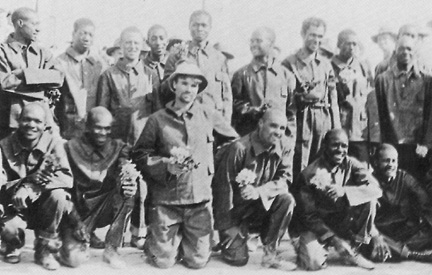
Return of the 10th Cavalry men captured in the Battle
at Carrizal, Mexico, 21 June 1916. In the center is Lem Spillsbury, 10th
Cavalry guide, who was captured, and the other members of the unit. This
photo is believed to have been taken on the International Bridge at El Paso,
Texas. Photo courtesy Lt. Col. John Healy, USA Retired.
The Mexicans lost their commander, General Felix U. Gomez, and eleven other officers. Thirty-three of their enlisted were killed and 53 others wounded. They were disorganized enough to lose their advantage and many of the American troopers avoided capture by escaping on foot into the countryside to be picked up later by rescuing troops.
Troop K, lost contact with Troop C at a crucial moment and did not support them, a fact that Major Frank Tompkins has written meant the difference between victory and defeat.
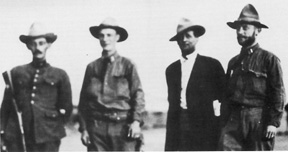
Capt. G.F. Trevino of General Garcia's Staff (Carranzistas),
Lt. Henry R. Adair, Lt. B.S. Fox, Lt. R.F. Migdalski. Trevino ultimately
issued the Carranzista order for U.S. Troops to turn around and go home.
Lt. Adair, along with Captain Charles T. Boyd, was killed by Carranzista
Troops at Carrizal, Chihuahua on June 21, 1916. Streets at either end of
Fort Huachuca parade ground are named for these two officers. National Archives
Series 94-UM-200067.
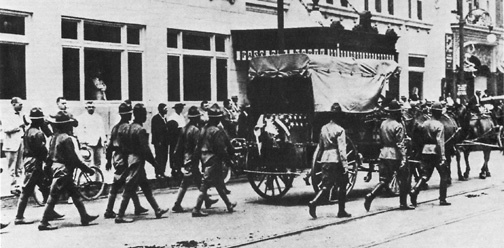
Funeral of Captain Charles Trumbull Boyd, 10th Cavalry,
who was killed in the Battle of Carrizal, Mexico, on 21 June 1916. The cortege
is followed by survivors of Troop C. Photo courtesy Int. Film Service, from
"Album of Pictures Somewhere in Mexico, Relating to U.S. Soldiers and
Mexicans," copyrighted 1916, by J.D. Givens, San Francisco, California.
General Pershing officially mourned the loss of Captain Boyd and Lieutenant Adair. "The memory of the splendid bravery of these two officers, who lost their lives, and of the men who personally followed them is cherished by this entire command."(74)
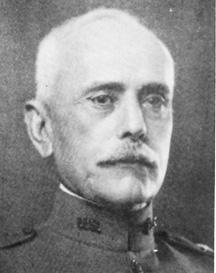 DeRosey C. Cabell.
DeRosey C. Cabell.
Lieutenant Jerome Howe had been detached from Troop K to serve as aide to Colonel Dodd, commanding the 2d Cavalry Brigade. The news of the defeat of his old troop and his personal relationship to the men affected him strongly. "I had been serving with the 10th Cavalry and with Troop K since the beginning of my Regular Army life in 1912. 1 was strongly attached to my Negro non-coms and troopers, and I grieved for Boyd and Adair whom I had known well and admired."(75)
The American accounts of the action at Carrizal were set down by fellow officers who mourned the loss of two brave comrades. They rightly find a great deal of heroism in the American defeat. Because he gave his life, along with the lives of others of his command, he was spared the post-battle examination and criticism. It would seem that Boyd erred gravely by taking on the Mexicans. At least one officer was puzzled by the actions of the experienced Boyd. Lieut. Jerome Howe later wrote:
...Why should Captain Boyd, despite the contrary advice of Captain Morey, have insisted on an attempt to assail this obviously tough position, apparently without necessity? We of the 10th Cavalry considered him an able, shrewd, dependable officer. This action seemed unlike him. Our opinion was inclined to the view that General Pershing, perhaps uneasy over the forced inactivity, desired to bring on an incident that would justify him in moving over vigorously with a large body of troops of all arms and bringing on a war with Mexico which could easily be won, and by means of which his own reputation would be greatly enhanced. Pershing himself never offered an explanation.(76)
The ranch foreman of the Santa Domingo Ranch, Mr. W. P. McCabe, said he overheard Captain Morey telling Boyd that he did not think it wise to force their way through the Mexican position but would obey Boyd's orders. Boyd "then made some remark to Captain Morey about 'making history' which I did not catch the rest of."(77)
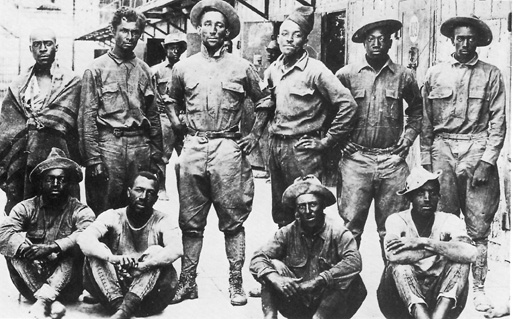
Men of the 10th Cavalry taken prisoner at the battle
of Carrizal, Mexico.
Boyd's orders were to avoid a fight. The Mexicans were in good defensive positions, were in far greater numbers, and had the superior firepower offered by machine guns. Adair was an experienced officer who was probably familiar with Marshal Saxe's axiom that it is wiser to decline an attack unless you can make it with advantage. But he did not need textbook proscriptions to tell him the lethality of charging into the teeth of clearly superior firepower. He was undoubtedly aware of the devastating effect machine gun fire had on cavalry attacking defensive positions in both the Boer War (1899-1902) and the Russo-Japanese War (1904-05). But if some accounts are to be believed, Boyd was determined to have a fight and maybe in the process "make history." Perhaps a too highly formalized sense of honor prevented withdrawal in the face of an enemy considered craven and backward. It would seem then to be a misstep of arrogance. Make history he did. It was a tragic finish for the Punitive Expedition.
Events in Europe in January 1917 were drawing the United States into World War I and President Wilson was forced to order the withdrawal of the Punitive Expedition from Mexico. The troops marched out of Colonia Dublan on January 30th and recrossed the border at Columbus, New Mexico, on February 5, 1917. Colonel Brown was retired now and Colonel DeRosey C. Cabell now commanded the regiment. The expedition had accomplished its mission of dispersing the villistas and the attendant threat of raids on U.S. border settlements without having actually come to grips with Villa himself.

"Gen. Pershing Reviewing the Troops on their
Return from Mexico." Photo by W. H. Horne, El Paso, Texas.
When Carranza, the leader of the Constitutionalist regime, was assassinated on May 21, 1920, he was replaced by Adolfo de la Huerta who made peace with Villa and even presented him with a large rancho upon which to retire along with his remaining followers. Pancho Villa was assassinated in an ambush outside of Parral on July 23, 1923.
Footnotes:
71. Henry Houston, whose account of the battle of Carrizal reveals the fighting quality of the 10th Cavalry soldier, was commissioned a captain in World War 1. H e is quoted in Carroll, John M., The Black Military Experience in the American West, Liverwright Publishing Co., 1971, 499-502.
72. On October 15, 1917, 1st Sergeant Henry Houston and Sergeant Howard Donovan Queen were commissioned captains after completing an officers' training camp in Des Moines, Iowa. Queen, the son of a 10th Cavalry sergeant who had fought in the Indian campaigns, rose to the rank of Colonel and commanded the all-black 366th Infantry Regiment, 92d Division, in Italy during World War 11. After the war he became a high school principal in Parkersburg, PA.
74. Howe, Jerome W., "Campaigning in Mexico, 1916," The Journal of Arizona History, Part 1, Autumn 1966; Part 2, Winter 1966.